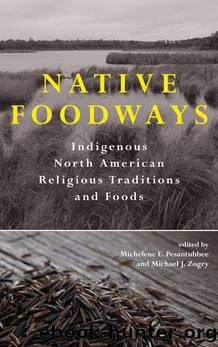Native Foodways by Michelene E. Pesantubbee Michael J. Zogry

Author:Michelene E. Pesantubbee, Michael J. Zogry [Michelene E. Pesantubbee, Michael J. Zogry]
Language: eng
Format: epub
ISBN: 9781438482620
Barnesnoble:
Publisher: State University of New York Press
Published: 2021-07-02T00:00:00+00:00
TÅįchÇ« Dene Caribou Hunting and Restrictions
TÅįchÇ« hunt tundra caribou twice yearly as the animals migrate through TÅįchÇ« lands. TÅįchÇ« hunting practices have altered over time, particularly with the introduction of a settled lifestyle and snowmobiles, but practices have remained remarkably consistent.12 Helm states that caribou migration fluctuates according to weather and food availability, meaning that exact times and locations for when and where a herd migrates through TÅįchÇ« lands varies substantially.13 However, TÅįchÇ« elders tell me that their knowledge of caribou movement proves accurate for each migration.
The Bathurst caribouâs fall migration is south from their calving grounds near Bathurst Inlet on the arctic coast, to the tree line between the tundra and the boreal forest on the eastern edge of TÅįchÇ« lands. In December Bathurst migrate southwest to the boreal forest near the four TÅįchÇ« communities of BehchokÇ«Ì, Whatì, Gamètì, and Wekweètì, before the herd returns to the tundra in March. The Bluenose East, the secondary herd for TÅįchÇ« hunters, travel northwest and west of the four TÅįchÇ« communities in winter, making the Bathurst herd more convenient for hunting. TÅįchÇ« have appropriated scientific caribou herd categorizations that distinguish between the Bathurst and the Bluenose East in order to comply with hunting restrictions. However, TÅįchÇ« traditionally only distinguish between migratory tundra caribou, ekwÇ«Ì, and boreal woodland caribou, tÇ«dzi. The latter do not migrate, live in different ecological settings, and have morphological differences from tundra caribou. The Bluenose East and the Bathurst herds are both tundra caribou but are distinguished based on breeding lines; the herds maintain separate calving grounds in May, with the Bluenose Eastâs calving grounds closer to the Arctic Ocean than the Bathurstâs. Both herds are scientifically classified as Rangifer tarandus groenlandicus.
On January 1, 2010, the Government of the Northwest Territories, citing concerns over an âaccelerated rate of decline,â implemented a temporary hunting ban on the Bathurst herd.14 The Bluenose East herd was originally placed under this ban, which was lifted for indigenous hunters although some hunting restrictions were later self-imposed by Dene hunters from Deline.15 The ban consisted of a no-hunting zone for caribou stretching east and north from Great Slave Lake in the Northwest Territories to the Nunavut border, covering hunting territory of TÅįchÇ« and Yellowknives Dene, North Slave Métis, Northwest Territoriesâ nonindigenous resident hunters, and Northwest Territoriesâ tourist hunting outfitters.
TÅįchÇ« elders told me of lean times in the past without caribou. However, Environment and Natural Resources, the Government of the Northwest Territoriesâ authority on wildlife management, found that the contemporary population decline of the Bathurst herd constituted a crisis in the species that required government intervention. In the mid-1980s, Environment and Natural Resources wildlife biologists estimated the Bathurst caribou herd population at 475,000 animals. From the late 1980s to the early 1990s, the Bathurst herd declined to 350,000 animals. The Bathurst herd continued a steady decline to an estimated 166,000 in 2006, then plummeted to less than 32,000 animals in 2009 and remaining stable until 2012.16 Wildlife biologists determined that reduced calf survival, compounded by reduced survival of adult females, caused the Bathurstâs 5 percent annual decline.
Download
This site does not store any files on its server. We only index and link to content provided by other sites. Please contact the content providers to delete copyright contents if any and email us, we'll remove relevant links or contents immediately.
| Native American | Popol Vuh |
| Rastafari Movement |
The Four Agreements by Don Miguel Ruiz(6619)
Breaking Free by Rachel Jeffs(4174)
The Hatha Yoga Pradipika (Translated) by Svatmarama(3227)
120 Days of Sodom by Marquis de Sade(3177)
Member of the Family by Dianne Lake(2302)
The Tao of Physics by Fritjof Capra(2227)
The Psychedelic Gospels: The Secret History of Hallucinogens in Christianity by Jerry B. Brown(2120)
The Road to Jonestown by Jeff Guinn(2019)
Going Clear: Scientology, Hollywood, and the Prison of Belief by Lawrence Wright(1935)
Going Clear by Lawrence Wright(1921)
Uriel's Machine by Christopher Knight(1862)
The Grand Grimoire: The Red Dragon by Author Unknown(1759)
The Gnostic Gospel of St. Thomas by Tau Malachi(1736)
Key to the Sacred Pattern: The Untold Story of Rennes-le-Chateau by Henry Lincoln(1592)
The Malloreon: Book 02 - King of the Murgos by David Eddings(1554)
Waco by David Thibodeau & Leon Whiteson & Aviva Layton(1530)
The New World Order Book by Nick Redfern(1525)
Animal Speak by Ted Andrews(1513)
The Secret of the Temple by John Michael Greer(1463)
